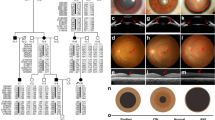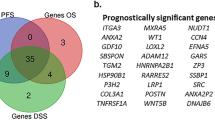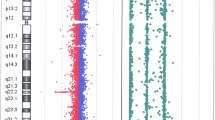Abstract
Beckwith–Wiedemann syndrome (BWS) is characterized by cancer predisposition, overgrowth and highly variable association of macroglossia, abdominal wall defects, nephrourological anomalies, nevus flammeus, ear malformations, hypoglycemia, hemihyperplasia, and organomegaly. BWS molecular defects, causing alteration of expression or activity of the genes regulated by two imprinting centres (IC) in the 11p15 chromosomal region, are also heterogeneous. In this paper we define (epi)genotype–phenotype correlations in molecularly confirmed BWS patients. The characteristics of 318 BWS patients with proven molecular defect were compared among the main four molecular subclasses: IC2 loss of methylation (IC2-LoM, n=190), IC1 gain of methylation (IC1-GoM, n=31), chromosome 11p15 paternal uniparental disomy (UPD, n=87), and cyclin-dependent kinase inhibitor 1C gene (CDKN1C) variants (n=10). A characteristic growth pattern was found in each group; neonatal macrosomia was almost constant in IC1-GoM, postnatal overgrowth in IC2-LoM, and hemihyperplasia more common in UPD (P<0.001). Exomphalos was more common in IC2/CDKN1C patients (P<0.001). Renal defects were typical of UPD/IC1 patients, uretheral malformations of IC1-GoM cases (P<0.001). Ear anomalies and nevus flammeus were associated with IC2/CDKN1C genotype (P<0.001). Macroglossia was less common among UPD patients (P<0.001). Wilms’ tumor was associated with IC1-GoM or UPD and never observed in IC2-LoM patients (P<0.001). Hepatoblastoma occurred only in UPD cases. Cancer risk was lower in IC2/CDKN1C, intermediate in UPD, and very high in IC1 cases (P=0.009). In conclusion, (epi)genotype–phenotype correlations define four different phenotypic BWS profiles with some degree of clinical overlap. These observations impact clinical care allowing to move toward (epi) genotype-based follow-up and cancer screening.
Similar content being viewed by others
Log in or create a free account to read this content
Gain free access to this article, as well as selected content from this journal and more on nature.com
or
References
Mussa A, Russo S, De Crescenzo A et al: Prevalence of Beckwith-Wiedemann syndrome in North West of Italy. Am J Med Genet A 2013; 161: 2481–2486.
Shuman C, Beckwith JB, Smith AC, Weksberg R : Beckwith-Wiedemann Syndrome; in Pagon RA, Adam MP, Bird TD, Dolan CR, Fong CT, Stephens K (eds): GeneReviews. Seattle (WA), University of Washington: Seattle, 1993-2013.
Weksberg R, Shuman C, Beckwith JB : Beckwith-Wiedemann syndrome. Eur J Hum Genet 2010; 18: 8–14.
Rump P, Zeegers MP, van Essen AJ : Tumor risk in Beckwith-Wiedemann syndrome: a review and meta-analysis. Am J Med Genet A 2005; 136: 95–104.
Choufani S, Shuman C, Weksberg R : Molecular findings in Beckwith-Wiedemann syndrome. Am J Med Genet C Semin Med Genet 2013; 163C: 131–140.
Eggermann T, Algar E, Lapunzina P et al: Clinical utility gene card for: Beckwith-WiedemannaSyndrome. Eur J Hum Genet 2014; 22; doi:10.1038/ejhg.2013.132.
Zimmerman DL, Boddy CS, Schoenherr CS : Oct4/Sox2 binding sites contribute to maintaining hypomethylation of the maternal igf2/h19 imprinting control region. PLoS One 2013; 8: e81962.
Abi Habib W, Azzi S, Brioude F et al: Extensive investigation of the IGF2/H19 imprinting control region reveals novel OCT4/SOX2 binding site defects associated with specific methylation patterns in Beckwith-Wiedemann syndrome. Hum Mol Genet 2014; 23: 5763–5773.
Cooper WN, Luharia A, Evans GA et al: Molecular subtypes and phenotypic expression of Beckwith-Wiedemann syndrome. Eur J Hum Genet 2005; 13: 1025–1032.
Brioude F, Lacoste A, Netchine I et al: Beckwith-Wiedemann syndrome: growth pattern and tumor risk according to molecular mechanism, and guidelines for tumor surveillance. Horm Res Paediatr 2013; 80: 457–465.
Mussa A, Peruzzi L, Chiesa N et al: Nephrological findings and genotype-phenotype correlation in Beckwith-Wiedemann syndrome. Pediatr Nephrol 2012; 27: 397–406.
Choufani S, Shuman C, Weksberg R : Beckwith-Wiedemann syndrome. Am J Med Genet C Semin Med Genet 2010; 154C: 343–354.
Ibrahim A, Kirby G, Hardy C et al: Methylation analysis and diagnostics of Beckwith-Wiedemann syndrome in 1,000 subjects. Clin Epigenetics 2014; 6: 11.
Bertino E, Spada E, Occhi L et al: Neonatal anthropometric charts: the Italian neonatal study compared with other European studies. J Pediatr Gastroenterol Nutr 2010; 51: 353–361.
Alders M, Bliek J, vd Lip K, vd Bogaard R, Mannens M : Determination of KCNQ1OT1 and H19 methylation levels in BWS and SRS patients using methylation-sensitive high-resolution melting analysis. Eur J Hum Genet 2009; 17: 467–473.
Priolo M, Sparago A, Mammì C et al: MS-MLPA is a specific and sensitive technique for detecting all chromosome 11p15.5 imprinting defects of BWS and SRS in a single-tube experiment. Eur J Hum Genet 2008; 16: 565–571.
Bliek J, Verde G, Callaway J et al: Hypomethylation at multiple maternally methylated imprinted regions including PLAGL1 and GNAS loci in Beckwith-Wiedemann syndrome. Eur J Hum Genet 2009; 17: 611–619.
Russo S, Mencarelli M, Cavalleri F et al: A fluorescent method for detecting low-grade 11patUPD mosaicism in Beckwith-Wiedemann syndrome. Mol Cell Probes 2003; 17: 295–299.
Romanelli V, Belinchón A, Benito-Sanz S et al: CDKN1C (p57(Kip2)) analysis in Beckwith-Wiedemann syndrome (BWS) patients: Genotype-phenotype correlations, novel mutations, and polymorphisms. Am J Med Genet A 2010; 152A: 1390–1397.
Fokkema IF, Taschner PE, Schaafsma GC, Celli J, Laros JF, den Dunnen JT : LOVD v.2.0: the next generation in gene variant databases. Hum Mutat 2011; 32: 557–563.
Chiesa N, De Crescenzo A, Mishra K et al: The KCNQ1OT1 imprinting control region and non-coding RNA: new properties derived from the study of Beckwith-Wiedemann syndrome and Silver-Russell syndrome cases. Hum Mol Genet 2012; 21: 10–25.
Riccio A, Sparago A, Verde G et al: Inherited and sporadic epimutations at the IGF2-H19 locus in Beckwith-Wiedemann syndrome and Wilms' tumor. Endocr Dev 2009; 14: 1–9.
Cerrato F, Sparago A, Verde G et al: Different mechanisms cause imprinting defects at the IGF2/H19 locus in Beckwith-Wiedemann syndrome and Wilms' tumour. Hum Mol Genet 2008; 17: 1427–1435.
Sparago A, Cerrato F, Vernucci M et al: Microdeletions in the human H19 DMR result in loss of IGF2 imprinting and Beckwith-Wiedemann syndrome. Nat Genet 2004; 36: 958–960.
Sparago A, Russo S, Cerrato F et al: Mechanisms causing imprinting defects in familial Beckwith-Wiedemann syndrome with Wilms' tumour. Hum Mol Genet 2007; 16: 254–264.
De Crescenzo A, Coppola F, Falco P et al: A novel microdeletion in the IGF2/H19 Imprinting Centre Region defines a recurrent mutation mechanism in familial Beckwith-Wiedemann syndrome. Eur J Med Genet 2011; 54: e451–e454.
Chang AS, Moley KH, Wangler M, Feinberg AP, Debaun MR : Association between Beckwith-Wiedemann syndrome and assisted reproductive technology: a case series of 19 patients. Fertil Steril 2005; 83: 349–354.
Bliek J, Gicquel C, Maas S et al: Epigenotyping as a tool for the prediction of tumor risk and tumor type in patients with Beckwith-Wiedemann syndrome (BWS). J Pediatr 2004; 145: 796–799.
Lam WW, Hatada I, Ohishi S et al: Analysis of germline CDKN1C (p57KIP2) mutations in familial and sporadic Beckwith-Wiedemann syndrome (BWS) provides a novel genotype-phenotype correlation. J Med Genet 1999; 36: 518–523.
Calvello M, Tabano S, Colapietro P et al: Quantitative DNA methylation analysis improves epigenotype-phenotype correlations in Beckwith-Wiedemann syndrome. Epigenetics 2013; 8: 1053–1060.
Smith AC, Shuman C, Chitayat D et al: Severe presentation of Beckwith-Wiedemann syndrome associated with high levels of constitutional paternal uniparental disomy for chromosome 11p15. Am J Med Genet A 2007; 143A: 3010–3015.
Itoh N, Becroft DM, Reeve AE, Morison IM : Proportion of cells with paternal 11p15 uniparental disomy correlates with organ enlargement in Wiedemann-beckwith syndrome. Am J Med Genet 2000; 92: 111–116.
Romanelli V, Meneses HN, Fernández L et al: Beckwith-Wiedemann syndrome and uniparental disomy 11p: fine mapping of the recombination breakpoints and evaluation of several techniques. Eur J Hum Genet 2011; 19: 416–421.
Kalish JM, Conlin LK, Bhatti TR et al: Clinical features of three girls with mosaic genome-wide paternal uniparental isodisomy. Am J Med Genet A 2013; 161A: 1929–1939.
Inbar-Feigenberg M, Choufani S, Cytrynbaum C et al: Mosaicism for genome-wide paternal uniparental disomy with features of multiple imprinting disorders: diagnostic and management issues. Am J Med Genet A 2013; 161A: 13–20.
Halliday J, Oke K, Breheny S, Algar E, J Amor D : Beckwith-Wiedemann syndrome and IVF: a case-control study. Am J Hum Genet 2004; 75: 526–528.
Sutcliffe AG, Peters CJ, Bowdin S et al: Assisted reproductive therapies and imprinting disorders—a preliminary British survey. Hum Reprod 2006; 21: 1009–1011.
Hiura H, Okae H, Miyauchi N et al: Characterization of DNA methylation errors in patients with imprinting disorders conceived by assisted reproduction technologies. Hum Reprod 2012; 27: 2541–2548.
Kupka MS, Ferraretti AP, de Mouzon J et al: ARTAssisted reproductive technology in Europe, 2010: results generated from European registers by ESHRE. Hum Reprod 2014; 29: 2099–2113.
Weksberg R, Nishikawa J, Caluseriu O et al: Tumor development in the Beckwith-Wiedemann syndrome is associated with a variety of constitutional molecular 11p15 alterations including imprinting defects of KCNQ1OT1. Hum Mol Genet 2001; 10: 2989–3000.
Cohen MM Jr : Beckwith-Wiedemann syndrome: historical, clinicopathological, and etiopathogenetic perspectives. Pediatr Dev Pathol 2005; 8: 287–304.
Cappuccio G, De Crescenzo A, Ciancia G et al: Giant breast tumors in a patient with Beckwith-Wiedemann syndrome. Am J Med Genet A 2014; 164A: 182–185.
McNeil DE, Brown M, Ching A, DeBaun MR : Screening for Wilms tumor and hepatoblastoma in children with Beckwith-Wiedemann syndromes: a cost-effective model. Med Pediatr Oncol 2001; 37: 349–356.
Scott RH, Walker L, Olsen ØE et al: Surveillance for Wilms tumour in at-risk children: pragmatic recommendations for best practice. Arch Dis Child 2006; 91: 995–999.
Mussa A, Pagliardini S, Paglirdini V et al: Alpha-fetoprotein assay on dried blood spot for hepatoblastoma screening in children with overgrowth-cancer predisposition syndromes. Pediatr Res 2014; 76: 544–548.
Mussa A, Ferrero GB, Ceoloni B et al: Neonatal hepatoblastoma in a newborn with severe phenotype of Beckwith-Wiedemann syndrome. Eur J Pediatr 2011; 170: 1407–1411.
Zarate YA, Mena R, Martin LJ et al: Experience with hemihyperplasia and Beckwith-Wiedemann syndrome surveillance protocol. Am J Med Genet A 2009; 149A: 1691–1697.
Acknowledgements
We thank all of the family members who participated in this study and the colleagues who referred patients. This research was supported by grants from MIUR PRIN 2009 (to AR, LL, and GBF), and Telethon-Italia grant no. GGP11122, EU-FP7-ITN INGENIUM no. 290123, Progetto Bandiera MIUR-CNR Epigenomica and Associazione Italiana Ricerca sul Cancro (to AR). LL and AR are members of the COST Action BM1208. We thank the Italian Onco-Hematological Association (Associazione Italiana Ematologia Oncologia Pediatrica, AIEOP) for providing access to cancer registry data. This research was supported by grants from MIUR PRIN 2009 (to AR, LL, and GBF), and Telethon-Italia grant no. GGP11122, EU-FP7-ITN INGENIUM no. 290123, Progetto Bandiera MIUR-CNR Epigenomica and Associazione Italiana Ricerca sul Cancro (to AR).
Author information
Authors and Affiliations
Corresponding authors
Ethics declarations
Competing interests
The authors declare no conflict of interest.
Appendix
Appendix
Here are the members of the Italian BWS collaborative group: C Anichini, MD, Department of Pediatrics, Obstetrics, and Reproductive Medicine, University of Siena, Siena, Italy; L Boccone, MD, Ospedale Regionale Microcitemie, Cagliari, Italy; A Bonfante, MD, Medical Genetics, Bassano del Grappa Hospital, Bassano del Grappa, Italy; D Concolino, MD, Department of Pediatrics, University of Catanzaro, Catanzaro, Italy; M Della Monica, MD, Medical Genetics Department, Gaetano Rummo Hospital, Benevento, Italy; R Fischetto, MD, Department of Metabolic and Genetic Disease, PO Giovanni XXIII, AOU Policlinico Consorziale, Bari, Italy; L Garavelli, MD, Clinical Genetics Unit, Obstetric and Paediatric Department, Arcispedale S Maria Nuova, Reggio Emilia, Italy; F Gurrieri, MD, PhD, Medical Genetics, School of Medicine, Catholic University, Roma, Italy; E Lapi, MD, Human Genetic Unit, Anna Meyer Children's University Hospital, Firenze, Italy; C Magnani, MD, Mather and Child Department, University of Parma, Parma, Italy; MG Patricelli, MD, Biologia Molecolare e Citogenetica, Diagnostica e Ricerca, Ospedale San Raffaele, Milano, Italy; M Piccione, MD, Dipartimento Materno Infantile, Università di Palermo, Palermo, Italy; GB Pozzan, MD, UO, Pediatria Mestre-Venezia, Italy; L Zelante, MD, Medical Genetics Unit, IRCCS Casa Sollievo Della Sofferenza Hospital, San Giovanni Rotondo, Italy.
Rights and permissions
About this article
Cite this article
Mussa, A., Russo, S., De Crescenzo, A. et al. (Epi)genotype–phenotype correlations in Beckwith–Wiedemann syndrome. Eur J Hum Genet 24, 183–190 (2016). https://doi.org/10.1038/ejhg.2015.88
Received:
Revised:
Accepted:
Published:
Issue date:
DOI: https://doi.org/10.1038/ejhg.2015.88
This article is cited by
-
Hallmark discoveries in the biology of Wilms tumour
Nature Reviews Urology (2024)
-
Molecular characterisation of 36 multilocus imprinting disturbance (MLID) patients: a comprehensive approach
Clinical Epigenetics (2023)
-
Biomaterials and advanced technologies for the evaluation and treatment of ovarian aging
Journal of Nanobiotechnology (2022)
-
Tumorprädispositionssyndrome und Nephroblastom
Die Radiologie (2022)
-
Prenatal ultrasound in fetuses with polycystic kidney appearance — expanding the diagnostic algorithm
Archives of Gynecology and Obstetrics (2022)



